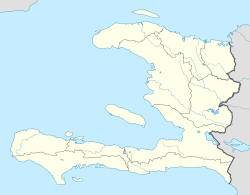Gonaïves, Haiti
|
Gonaïves Gonayiv |
|
|---|---|
| Commune | |

Cathedral of St. Charles Borromeo
|
|
| Nickname(s): La Cité de l'Indépendance The City of Independence |
|
| Location in Artibonite, Haiti | |
| Coordinates: 19°27′N 72°41′W / 19.450°N 72.683°W | |
| Country |
|
| Department | Artibonite |
| Arrondissement | Gonaïves |
| Government | |
| • Mayor | Neil Latorture |
| Elevation | 6 m (20 ft) |
| Population (2011) | |
| • Commune | 300,000 |
| • Metro | 104,825 |
| Time zone | Eastern (UTC-5) |
| • Summer (DST) | Eastern (UTC-4) |
Gonaïves (Haitian Creole: Gonayiv) is a commune in northern Haiti, and the capital of the Artibonite department of Haiti. It has a population of about 300,000 people (2011 census). The city of Gonaïves was founded in 1422 by Indians who named it Gonaibo (to designate a locality of cacicat of the Jaragua). It is also known as Haiti's "independence city". The Bay of Gonaïves is named after the town.
In 1802 an important battle of the Haitian Revolution, the Battle of Ravine-à-Couleuvres was fought near Gonaïves.
Gonaïves is also known as Haiti's City of Independence because it was there that Jean-Jacques Dessalines declared Haiti, the former Saint-Domingue, independent from France on January 1, 1804, by reading the Act of Independence, drafted by Boisrond Tonnerre, on the Place d'Armes of the town.
Marie-Claire Heureuse Félicité, the wife of Jean-Jacques Dessalines, died here in August 1858.
In the early 2000s, Gonaïves was the scene of substantial rioting and violence motivated primarily by opposition to President Jean-Bertrand Aristide, and on February 5, 2004, a group calling itself the Revolutionary Artibonite Resistance Front seized control of the city, starting the 2004 Haïtian rebellion. But in recent years the city has seen a complete return to calmness.
In September 2004, Hurricane Jeanne caused major flooding and mudslides in the city.
...
Wikipedia

